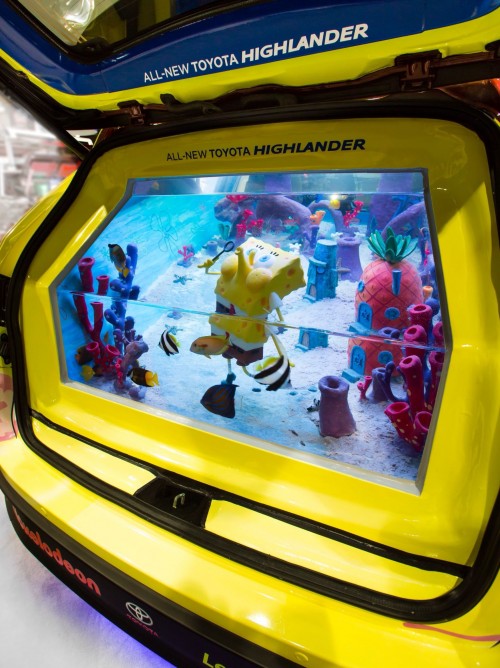By Peter Saunders
Identity Brand, a graphics company, teamed up last year with Acrylic Tank Manufacturing (ATM) owners Wayde King and Brett Raymer, hosts of the Animal Planet TV series Tanked, to create a custom-wrapped 2014 Highlander sport utility vehicle (SUV) for Toyota. Dubbed the ‘SUV-aquarium,’ it featured a fully functional 3,028-L (800-gal) saltwater fish tank, custom-fitted within the rear seat and cargo area, which required a built-in overflow filtration system, sterilizer, ultraviolet (UV) filter and temperature regulator. The exterior, meanwhile, was wrapped with graphics inspired by the popular kids’ TV series SpongeBob SquarePants and produced using a Roland DGA VersaCamm inkjet printer/cutter. Upon the project’s completion, the tank was filled with about 115 fish, representing 32 species.
“Thanks to a skilled group of professionals and the capabilities of specialized equipment, the result was an extremely happy group of clients,” says Phillip Dominguez, owner of Identity Brand.
While this eye-catching project was truly one-of-a-kind, it exemplifies the need for great precision at every phase of vehicle wrap projects, including design, printing and installation. Once ATM’s tank was installed, Dominguez’s crew had to match client colours from Toyota and Nickelodeon (which produces SpongeBob) flawlessly.
“Even though we printed the hood and rear a day after the side install, there was no variation between the colours,” Dominguez says.
Toyota’s SUV-aquarium appeared on the March 7, 2014 episode of Tanked after touring automotive events, including the 2013 Specialty Equipment Market Association (SEMA) Show in Las Vegas, Nev.
Developing best practices
Facing higher client expectations, it has been vital for the sign industry to develop best practices for vehicle graphics, particularly full-body wraps.
“Wrapping vehicles may be a common practice these days, but that does not mean it is easy,” says Jeff Stadelman, marketing manager for Mactac, which produces pressure-sensitive vinyl for the graphics industry. “Even experienced designers, printers and installers make mistakes or cut corners in an effort to speed up their processes. The impact can be seen either immediately or over the lifespan of the graphics.”
As Stadelman points out, the graphic design phase is key. Unlike most printed graphics, which are installed ‘flat’, vehicle wrap designs must account for complex contours, curves and rivets.
“Designers need to think in three dimensions,” he says, “accommodating for areas that will require extra material, such as door handles. And any messaging needs to be easily viewable and unobstructed by corners, adjoining side panels and mirrors.”
Printing and lamination
For printing wrap graphics, Stadelman emphasizes the importance of a clean, low-traffic, well-ventilated environment with controlled humidity between 40 and 60 per cent and optimal temperature between 21 and 24 C (70 and 75 F). This will help keep debris, dust and dirt away from the printheads and the media. Printer operators should wear gloves when handling the media, to avoid transferring oils and fingerprints.
“Static electricity can also affect how ink lays on a substrate, as it attracts dust and dirt,” he says. “Avoid carpets and rugs in the printing area and consider using ‘static string’ to dispel it cost-effectively.”
Another important step is choosing the right substrate. Many types of vinyl are available, such as marking films intended for decals, bubble-free films for full-body wraps and perforated films for windows, each of which will entail its own ‘print profile,’ including how much heat to apply, ink limits and International Color Consortium (ICC) data.







